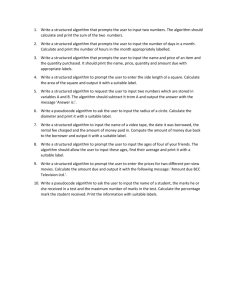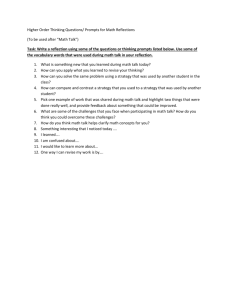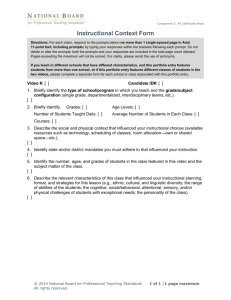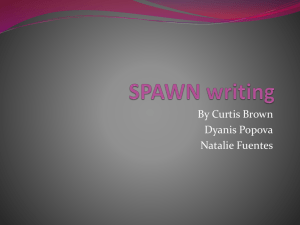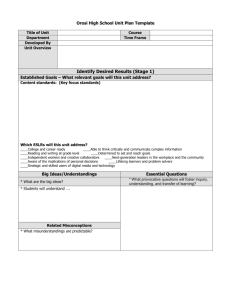WV Writes Guidelines for Building Teacher
advertisement
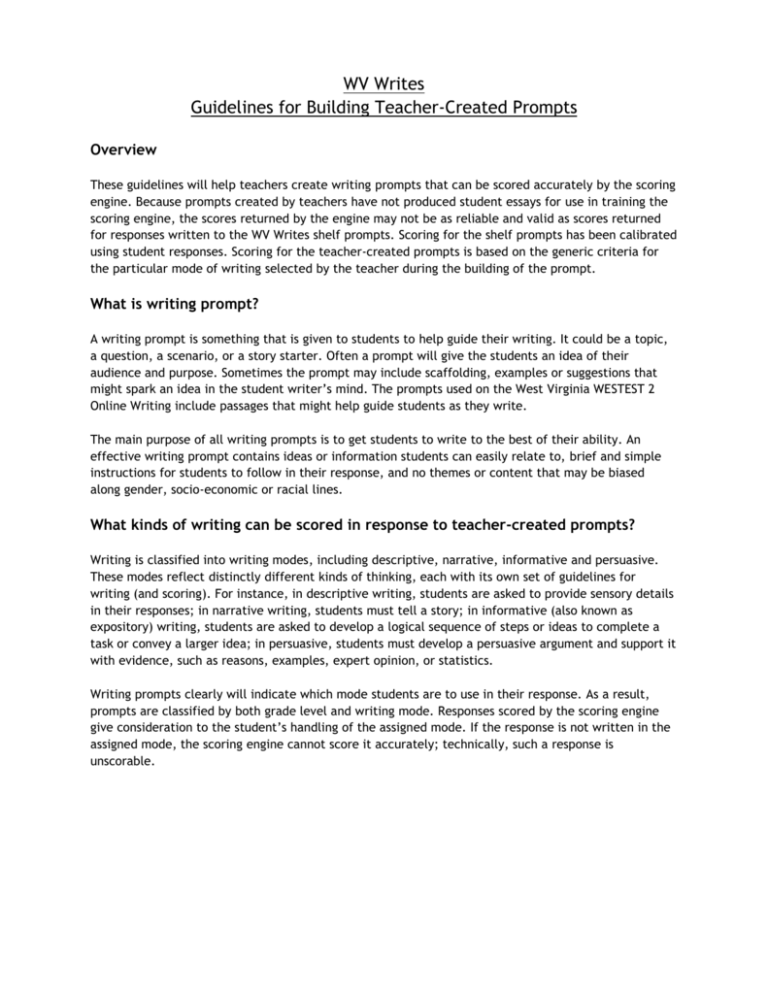
WV Writes Guidelines for Building Teacher-Created Prompts Overview These guidelines will help teachers create writing prompts that can be scored accurately by the scoring engine. Because prompts created by teachers have not produced student essays for use in training the scoring engine, the scores returned by the engine may not be as reliable and valid as scores returned for responses written to the WV Writes shelf prompts. Scoring for the shelf prompts has been calibrated using student responses. Scoring for the teacher-created prompts is based on the generic criteria for the particular mode of writing selected by the teacher during the building of the prompt. What is writing prompt? A writing prompt is something that is given to students to help guide their writing. It could be a topic, a question, a scenario, or a story starter. Often a prompt will give the students an idea of their audience and purpose. Sometimes the prompt may include scaffolding, examples or suggestions that might spark an idea in the student writer’s mind. The prompts used on the West Virginia WESTEST 2 Online Writing include passages that might help guide students as they write. The main purpose of all writing prompts is to get students to write to the best of their ability. An effective writing prompt contains ideas or information students can easily relate to, brief and simple instructions for students to follow in their response, and no themes or content that may be biased along gender, socio-economic or racial lines. What kinds of writing can be scored in response to teacher-created prompts? Writing is classified into writing modes, including descriptive, narrative, informative and persuasive. These modes reflect distinctly different kinds of thinking, each with its own set of guidelines for writing (and scoring). For instance, in descriptive writing, students are asked to provide sensory details in their responses; in narrative writing, students must tell a story; in informative (also known as expository) writing, students are asked to develop a logical sequence of steps or ideas to complete a task or convey a larger idea; in persuasive, students must develop a persuasive argument and support it with evidence, such as reasons, examples, expert opinion, or statistics. Writing prompts clearly will indicate which mode students are to use in their response. As a result, prompts are classified by both grade level and writing mode. Responses scored by the scoring engine give consideration to the student’s handling of the assigned mode. If the response is not written in the assigned mode, the scoring engine cannot score it accurately; technically, such a response is unscorable. What are the capabilities of the scoring engine for teacher-created prompts? WV Writes allows teachers to create their own prompts under the Assessments menu. Teachers may create prompts for each of the four genres – descriptive, narrative, informative and persuasive. Writing prompts are developed as either stand-alone or passage-dependent tasks. A stand-alone prompt assumes that students have the prior experience or knowledge referenced in the prompt, and thus are able to write their responses on the spot. This includes prompts that build on a simple quotation that is provided in full within the prompt. A passage-dependent prompt is based on students’ prior knowledge of a separate piece of writing - an excerpt, poem, story, article, essay, book – or a text chosen from a group of selections. The scoring engine will not accurately score responses to passage-dependent prompts. Neither will it accurately score any prompt that is content-driven - seeking a correct answer to a question or problem. However, teachers may still build prompts that include passages similar to those used on WESTEST 2 Online Writing because the passages help guide the students’ writing and student responses are not entirely dependent on the passage. The scoring engine measures writing skills by mode and grade. It will give accurate scores to standalone prompts only. The engine will apply prompt-specific logic, if possible, for the most accurate scoring, or else apply somewhat more generic logic, based on fewer modeling criteria. How can teachers develop appropriate teacher-created prompts? 1. Keep it simple. A highly ambitious prompt quickly becomes a reading comprehension exercise and may detract from students’ responses. 2. Ask students to write about one thing: A special day, a story about something dangerous, an opinion of the school’s dress code, how to make a sandwich – not, for example, a top-5 list of favorite books, or which two amendments of the Constitution do you disagree with most and why? 3. Always remember to assign subject matter with which all your students are familiar: bicycles, but not swimming pools; toys or TVs, but not video games; family, but not brothers; gym class, but not dancing. 4. Do not ask students to write about matters that may be construed as too personal. Such prompts do not elicit students’ best writing as they may feel too attached (or averse) to the subject to respond well. 5. Write stand-alone prompts only. If you need a literary component, use a simple aphorism or epigram from Bartlett’s Book of Quotations by Benjamin Franklin or Mark Twain. 6. Avoid prompts that will require students to use specialized vocabulary or unusual spellings because that might affect scoring in word choice and conventions.
